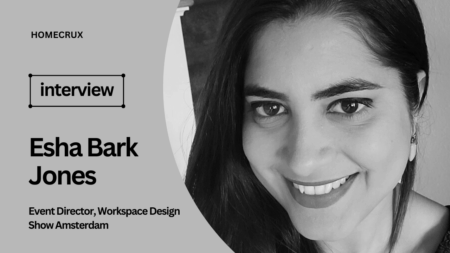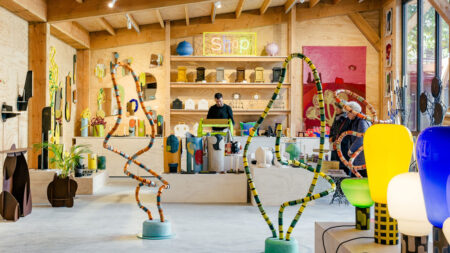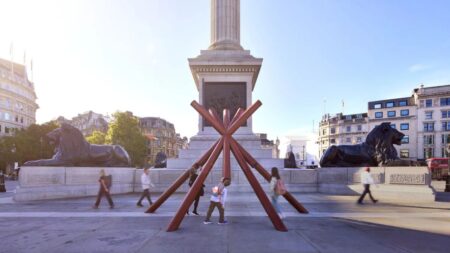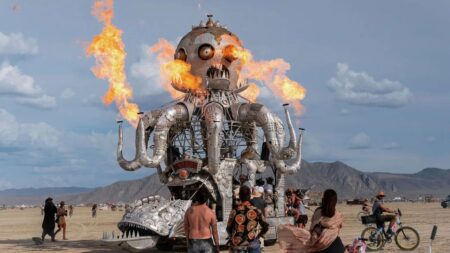Paul Denham Austerberry’s parents were not in attendance at the BAFTA 2018 ceremony – they were in Mexico – when their son held one of the most prestigious awards in production design. Then it was time for the Oscars. This wasn’t a moment they intended to miss. Paul’s parents flew from Mexico to LA and seated themselves in the mezzanine of the Dolby Theatre. Paul, on the other hand, was seated on the main orchestra toward the back of the theater under the balcony. His parents obviously had a better view of the stage than he did.
As presenters, Lupita Nyong’o and Kumail Nanjiani, walked up to the stage with the list of nominees for the Academy Award for Best Production Designer – comprising names of Sarah Greenwood, Nathan Crowley, and Dennis Gassner; all multiple-time nominees and undeniably the favorites to win, Paul and family would have skipped a beat. But then the moment of truth arrived. Leaving the stalwarts, in their own rights, behind, Paul Austerberry was adjudged the best production designer for “Shape of Water”: his first Oscar ever!
As he walked to collect the award, a loud cheer echoed in the Dolby Theatre, “That’s my son”! His father could be heard calling out in joy, while Paul delivered his historic speech, “Guillermo you keep dreaming up your monsters and their wonderful stories, so people like us can help shape their worlds”.
The emotional story was recently narrated by Paul himself in an interview with Homecrux. Five years have passed since his first Academy Award; one could assume that Paul must be busy with the next big thing in his career. But he is not! He is rather unemployed because of the ongoing strikes in Hollywood. Even though the actors and writers have reached a tentative argument with the studios, there is still a lot of uncertainty around resuming work. Homecrux caught up with Paul for his insights on the issue, and also to take a peek into the career of this Oscar-winning production designer. Let’s read what he has to say below:
Homecrux (HC): How is your day going?
Paul D. Austerberry (PA): The day, it’s not bad. It’s, the middle of the day and the weather’s good, can’t complain.
HC: Where are you as we speak?
PA: I’m currently in Toronto, I was born here, but I didn’t grow up here really. When I was three, my parents moved to Uganda. My father was a high school teacher and he was teaching for a foreign aid program out of Canada. So, we ended up living there for three years. Eventually, I grew up in Northern Ontario and then I ended up in a university in Ottawa, which is the capital, of course. I studied architecture for five years in Ottawa. Later, I moved back to my birthplace here in Toronto in 1989.
HC: Take us through your initial days of struggle. How did your journey begin?
PA: During 1989, there was a bit of a boom for architecture. So I worked for a couple of years. I fell in with a bunch of like-minded design people, but a lot of them worked in films, and the film business was sort of a burgeoning here, at the time. I didn’t pay much attention to it because I was still working as an architect, but I used to live in an area, where there used to be lots of film sets and lights. I could go, I’d ride my bike home late at night and I’d see all these trucks and people standing around.
I’d stand around till eternity and nothing seemed to happen. And maybe eventually some action thing happened and then there’s again a lot of standing around. But my curiosity was piqued by that. After working as an architect for two years, I went away travelling to Asia for about better part of a year in 90-91. I came back and the world was hit by a recession. There was not a lot of work for architects.

HC: Did you always dream of being a production designer or was it the turn of events that led you to become one?
PA: I wanted to be an architect, since the age of ten. I was one of those strange kids who didn’t want to be a spaceman or a fireman or anything like that. I, for some reason always wanted to be an architect. I still love architecture, but maybe I’m not patient enough because it takes a long time to realize something in architecture. A career in architecture usually takes a long time. I mean, most famous architects are in their fifties, before they become famous.
Not that I was trying to be famous or anything, or thought about being famous. It was more the fact that I was lucky. I ended up working for a small firm. We did lots of small projects. So, I was given control of small projects, meeting the clients, and going to all those site visits from start to finish in a project.
It might be just a house renovation or a small commercial store renovation, nothing massive. And a lot of my colleagues that I graduated with, they were working for larger, more prestigious firms, but they ended up just drawing, you know, window details and small mundane kind of things as to be expected.
Even though I was in a smaller firm, I got to cover more of the range of the development of a project from start to finish, which to me was more satisfying and gratifying. I still felt that it took forever just to do a small thing. There’s lots of bureaucratic paperwork and rules and things, which is fair enough, buildings shouldn’t fall down and they should keep the water out and keep all those practical things that should happen.
HC: What transpired the shift in career from architecture to production design?
PA As I said, I came back from my trip and I could have got a job as an architect, but at the time I thought, well, this is a chance for me to see and try other things. And I was remembering my friends who worked in film. So I spoke to my friend, Beth Pasternak, who was a costume designer and she was working on a small TV film.
I said, you know, I’m unemployed, I don’t have any money, but can I volunteer, what can I do to see what the art department is like in the film? So she spoke to the art director and she got me in on, it’s just a TV at the time they’re called the movie of the week. They were fairly low-budget movies that shot in about four or five weeks. And they ended up on television at the time before streamers and everything. And I was in the art department for four days.
The fourth day, the art director said, you know, there’s a paid job, driving the cube truck in the set decoration department, if you like. It’s a hundred dollars a day and, I know you need some money. So I said, okay, I’ll take it. You know, at the time it wasn’t the area that I wanted to be in. I wanted to be in the art department. I was watching people draw and seeing what that was about, and one of my colleagues from architecture school was actually on that production in the art department. So it made me figure that that’s probably where I should be. However, the art form was part of the union. So I took the job driving the truck and moving furniture and set dressing.
And during that course, I did two movies in a row with the same team. I ended up doing various jobs in the set decoration department. And it’s part of the time I was actually on set being on set props and not on set painter, on set carpenter helper, because, it was a small production and people had to do multi, multi roles.
At that point, I got to actually see filming going on and acting and understanding a little bit more about it. What the business was all about. So, it was actually an interesting beginning. I did that for, I think the better part of six months. I stuck with the same set decoration team and I worked with them. Eventually, I graduated from just driving the truck to realize I had a design eye and I had a good sense of it. So I ended up eventually becoming what they call a lead man.
Then I got to hire all my unemployed designer friends. At the time, I had industrial designers and architects – there were a lot of them unemployed because of the recession. So I ended up with a very very talented crew that was just not really in the film business, but we were just making some money and having a good time.
HC: What’s your take on the Hollywood strike?
PA: There are two strikes going on in Hollywood right now, and most of the productions that I work on are, U. S. based, so they’re affected by these American strikes, even though, I could be working in Canada, I could be working in Europe, a lot of those films that would be backed by those Big studios are all on hold or shut down at the moment. Every so often the contract renews and they (writers) just want to get a small percentage increase that’s pretty straightforward. And I don’t think there’s any real issue with those for the writers. They’re very worried about AI.
HC: How dangerous are AI and other tools for people who work in creative fields, especially directors, writers, and even production designers?
PA: Yes, AI is dangerous for the writers, obviously. The scripts can be generated like that, apparently, and then in our field, there’s software like Midjourney, with prompts, you can generate pretty interesting, illustrations, photo-realistic illustrations, or whatever style you would like it to be. And actually, you can generate them quite quickly
I haven’t really experimented with them, but I’ve watched many people who have generated them and it’s pretty incredible actually what, what can happen. So, you know, if you’re a concept illustrator, you know, it’s a little bit worrisome to see. So, yeah, AI is a big unknown and it’s a bit of a worry for all of us.
I chat to my art crew from England on The Flash and so many of them are really struggling right now. It’s, really affecting a lot of people. I mean, the strikes are obviously only for the actors and the writers, but it’s got a knock-on effect throughout the whole industry.
HC: A lot of production designers I talk to tell me that they avoid small-budget films, especially horror/comedy. It sort of diminishes your creativity and also creates an image within the film production industry that this production designer is maybe not suitable for a ‘serious niche’. How has it been with you?
PA: No, generally speaking, you hope to have some scripts, you read them and they’re incredibly visual scripts. Those are the kinds that are most interesting to a designer. Usually sometimes obviously the stories are the most important part. I mean, you can’t have a very good film without a good story. I suppose great stories don’t necessarily require an amazing design, depending on the story. It could be a very simple environment. However those environments have to be created, they have to be realistic.
Now you bring up small horror movies, obviously, there are lots of small horror movies around, because they’re the kind of movies that lots of young people like to see, and they actually tend to make quite a bit of money, it seems, for a fairly low budget. With horror movies, there are plenty of fun things to do usually from a design standpoint.
IT is a horror movie; it was a fairly big-budget horror movie. The second one anyway, we managed to create quite a number of interesting worlds and environments in that particular movie. No, I would not just take a movie. I’ve been fortunate that I have been able to do commercials in between, so I’m able to choose a decent script.
You know, you have to pay for your rent; you have to mortgages and things like that. So people have to work, but I’ve been able to not have to jump onto any particular film that comes my way because I’ve been able to segue into commercials for a while. My choice is open to decent design projects.
HC: How is the building process in general when you’re working on massive sets like Pompeii or Shape of Water?
PA: The good thing about Pompeii is it is one of the most documented films. The buildings have been unearthed that have been buried for centuries. They’re beautifully intact. There’s a plethora of research that was available for Pompeii. In production design, so much of what we do is based on good research, especially, you know, on a historical project like that. The best thing is just to pull as much reference material as possible at the very beginning, and then pull, pull your influences from there.
We shot mostly in the studio or in a parking lot of the studio or back lot here in Toronto and out in an overgrown rock quarry. So, CGI helps extend the distant worlds, but it was a challenge. It seems kind of crazy to try to do that all in that particular location, but that’s part of the joy and the excitement of what we do as in our job.

HC: Pompeii I assume was also the film where Guillermo Del Toro spotted you. And it is a film that actually made your career blossom. Brief us about the moment when you got to know that you’ve been chosen to do the Shape of Water.
PA: When I met Guillermo, he was producing or he was writing and going to direct, Pacific Rim 2. He had shot Pacific Rim 1 here in Toronto. I can’t remember what I was shooting at the time, but anyway, he shot that here and then he was developing the next one. So I met Guillermo. We chatted and he had been complimentary on several projects previous that I had done, that he had seen.
And, then we were developing that movie. And I worked on that movie for about eight weeks before, Guillermo decided he wasn’t going to pursue that one anymore. And he had this untitled fish movie, as he called it, that he wanted to shoot in black and white. And so I got the script for this untitled fish movie, which ended up being called The Shape of Water.
HC: How were the preparations for The Shape of Water, considering it relied a lot on stage aesthetics?
PA: Everyone had to be clever about how to make this film. And at the time Guillermo was working on a TV series here in Toronto called The Strain, and it was sort of a horror. I’ve never seen it, but it was a horror movie or a horror show, I should say. And at the end of, I think it was season three. They were just shooting season three when this all happened with Guillermo.
I was doing a commercial in LA, just before we started prepping. And so I met with Guillermo and I had done a few preliminary. Sketches and things like that to show him. And then when that commercial was over, about two weeks later, we started our production in Toronto. And that’s, that’s kind of how I ended up with Guillermo.
It didn’t go straight from Pompeii to Shape of Water. It went on to Pacific Rim 2. And then, and then we ended up doing, Shape of Water. It was supposed to be a black-and-white film when I first heard about it.
Color is very important in your toolkits as you plan to create environments. And to have that removed was quite challenging in my mind. I was kind of worried about it, and then Searchlight decided, we’ll give you a little bit more money. So thankfully, we did it and color ended up being dominant in the design of The Shape of Water.

HC: What were the challenges you had to overcome in making this movie? Especially when Guillermo demanded the lead character’s apartment to radiate water from all around?
PA: Yes, the main character’s apartment was supposed to evoke the world of water. The opening shot of the film tracks down this hallway and then goes into her apartment and Sally Hawkins (main character) is floating in the water and then drifts down onto her, her settee, and then the alarm goes off. Then the world wakes up and she’s not underwater.
Even so, we wanted to evoke the watery world feel in her space. Guillermo and I talked about her space had a water leak or a fire. And so there was water above and it ruined the roof. And there were always drips. There was always just dripping in our kitchen. Even in the wallpaper that we chose, we chose this sort of Victorian wallpaper that evoked fish scales to give it that little, foreshadow a little bit about her and also to create this world, this warm world for when she brings the fish man home. The set decoration, the couches had this sort of wave curve fields. There were lots of small little details to help shape that room to be, to be a little bit more aquatic.







Homecrux: Take us through that Oscar-winning moment of your life.
PA: It was pretty exuberant. I have to say, I mean, the whole the whole build-up to the Oscar is quite a road before you even get to the Oscars. I’d read about it before, but I didn’t know. I didn’t really understand what it entailed. And the road actually started at the Venice film festival when Shape of Water won.
I didn’t really have any thoughts about Oscars to be honest, until that point. And then at that point, when it won Venice, I realized, this movie is ‘going to squat legs’, it’s going to go, it’s a beautiful film, but it’s such an odd film that it could either going to love it or potentially hate it. I mean, it was a very, very strange thing. You’re walking that fine line. Guillermo was walking that fine line in this story, between massive success and failure.
There were all these events, and interviews. I went to the Film Festival, We went to LA and I was there for a week and there were just endless promotions, interviews and everything else. And then, the moment finally came, and I am glad my family members were with me.


HC: What are the upcoming projects you are working on?
PA: We’ve just finished with Color Purple. That’s a lovely film we did. We shot it in Atlanta, mostly last year. We shot it last year actually and I finished working on it in the middle of July last year. It’s a beautiful movie. I mean, it’s obviously a musical film based on Alice Walker’s book, which was then turned into Steven Spielberg’s movie from the 80s, and then and it became a Broadway, musical. But I am pretty excited to hear what people have to say about it.
Follow Homecrux on Google News!




